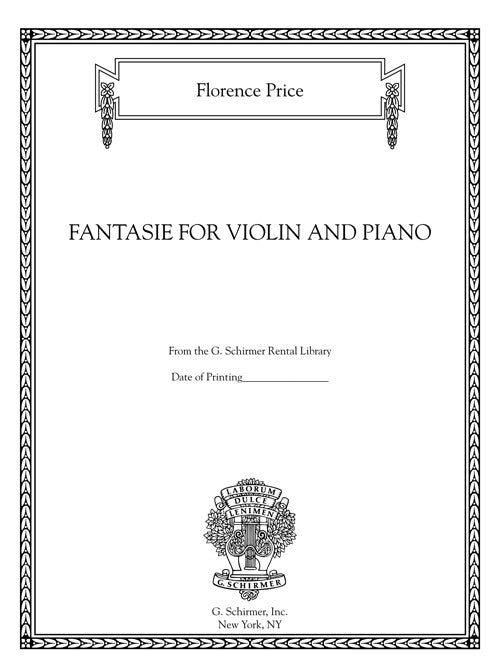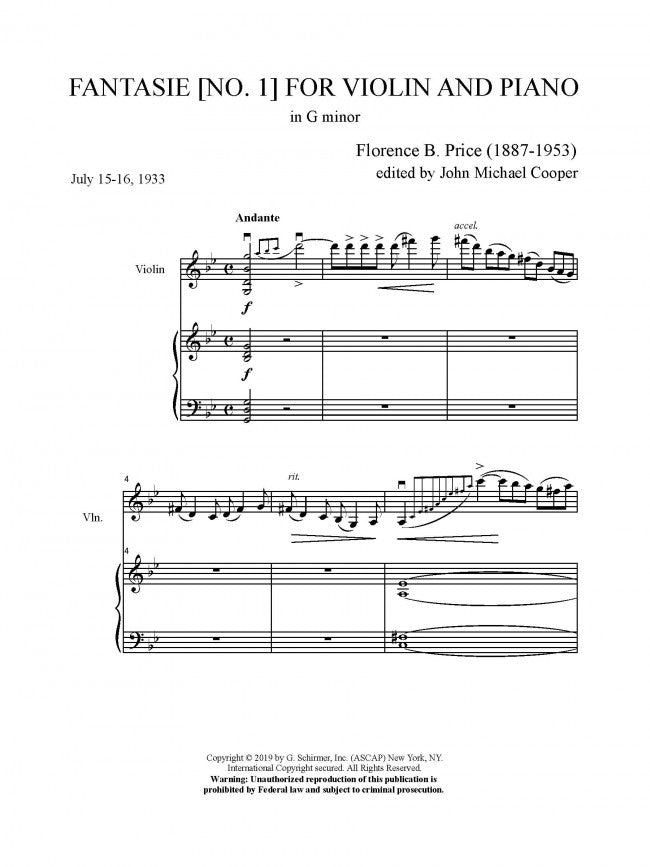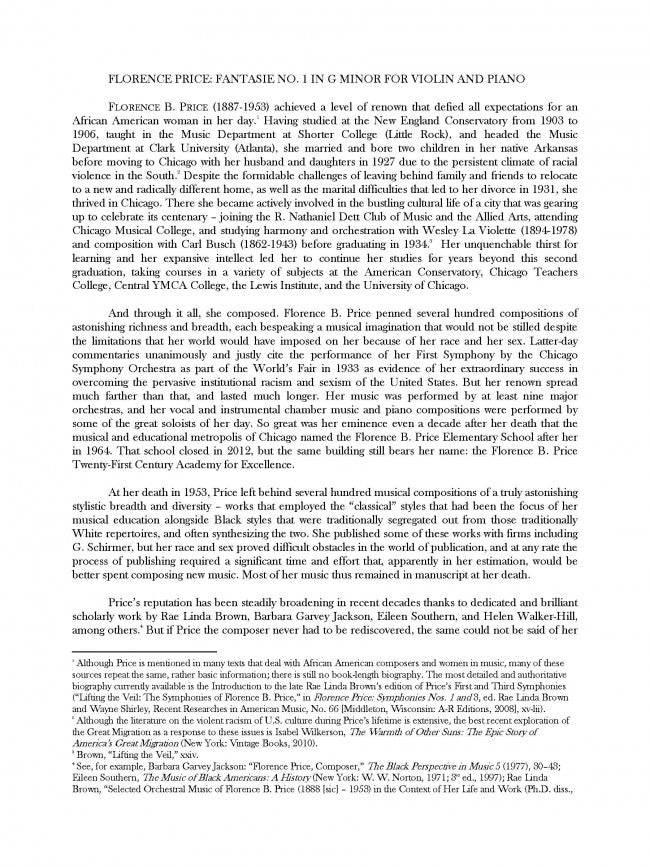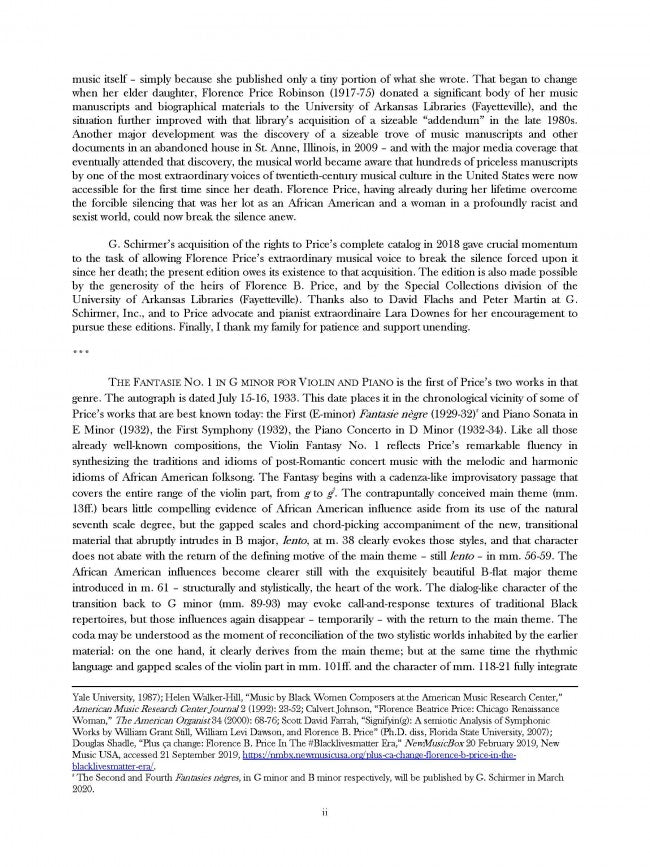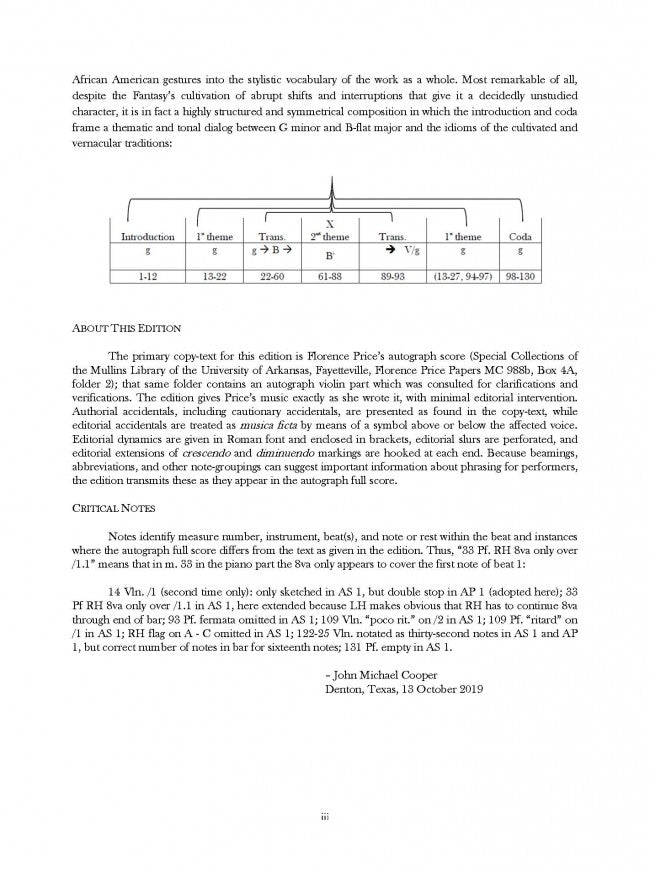Price: Fantasie No. 1 in G Minor
This item is made to order and typically ships within 1-2 weeks.
- Composer: Florence Price (1887-1953)
- Instrumentation: Piano, Violin
- Work: Fantasie No.1 in G Minor
- Size: 9.1 x 11.9 inches
Description
The Fantasie No. 1 in G Minor for violin and piano is the first of Price's two works in that genre. The autograph is dated July 15-16, 1933. This date places it in the chronological vicinity of some of Price's works that are best known today: the First (E-Minor) Fantasie nègre (1929-32)5 and Piano Sonata in E Minor (1932), the First Symphony (1932), the Piano Concerto in D Minor (1932-34). Like all those already well-known compositions, the Violin Fantasy No. 1 reflects Price's remarkable fluency in synthesizing the traditions and idioms of post-Romantic concert music with the melodic and harmonic idioms of African American folksong.The Fantasy begins with a cadenza-like improvisatory passage that covers the entire range of the violin part, from g to g3. The contrapuntally conceived main theme (mm. 13ff.) bears little compelling evidence of African American influence aside from its use of the natural seventh scale degree, but the gapped scales and chord-picking accompaniment of the new, transitional material that abruptly intrudes in B Major, lento, at m. 38 clearly evokes those styles, and that character does not abate with the return of the defining motive of the main theme — still lento — in mm. 56-59.
The African American influences become clearer still with the exquisitely beautiful B-flat Major theme introduced in m. 61 — structurally and stylistically, the heart of the work. The dialog-like character of the transition back to G Minor (mm. 89-93) may evoke call-and-response textures of traditional Black repertoires, but those influences again disappear — temporarily — with the return to the main theme. The coda may be understood as the moment of reconciliation of the two stylistic worlds inhabited by the earlier material: on the one hand, it clearly derives from the main theme; but at the same time the rhythmic language and gapped scales of the violin part in mm. 101ff. and the character of mm. 118-21 fully integrate African American gestures into the stylistic vocabulary of the work as a whole. Most remarkable of all, despite the Fantasy's cultivation of abrupt shifts and interruptions that give it a decidedly unstudied character, it is in fact a highly structured and symmetrical composition in which the introduction and coda frame a thematic and tonal dialog between G Minor and B-flat Major and the idioms of the cultivated and vernacular traditions.— John Michael Cooper
Publishers use a lot of words to describe what they sell, and we know it can be confusing. We've tried to be as clear as possible to make sure you get exactly what you are looking for. Below are descriptions of the terms that we use to describe the various formats that music often comes in.
Choral Score
A score for vocalists that only contains the vocal lines. The instrumental parts are not there for reference. Generally, cheaper than a vocal score and requires multiple copies for purchase.
Facsimile
Reproductions of the original hand-written scores from the composer.
Full Score
For ensemble music, this indicates that the edition contains all parts on a single system (there are not separate parts for each player). In larger ensembles, this is for the conductor.
Hardcover
Hardbound. Generally either linen-covered or half-leather.
Orchestral Parts
Similar to a wind set, this is a collection of parts. In the case of strings, the numbers listed are the number of copies included, though generally these are available individually (often with minimum quantities required).
Paperback
When publishers offer multiple bindings (e.g. hardcover) or study scores, this is the "standard" version. If you're planning to play the music, this is probably what you want.
Performance / Playing Score
A score of the music containing all parts on one system, intended for players to share. There are not separate parts for each player.
Set of Parts
For ensemble music, this indicates that there are separate individual parts for each player.
Solo Part with Piano Reduction
For solo pieces with orchestra, this is a version that contains a piano reduction of the orchestra parts. For piano pieces, two copies are typically needed for performance.
Study Score
A small (think choral size) copy of the complete score meant for studying, and not playing. They make great add-ons when learning concertos and small chamber works.
Vocal Score
A score prepared for vocalists that includes the piano/organ part or a reduction of the instrumental parts.
Wind Set
For orchestral music, this is a collection of wind and percussion parts. The specific quantities of each instrument are notated.
With Audio
In addition to the printed music, the edition contains recordings of the pieces. This may be an included CD, or access to files on the internet.
With / Without Fingering (Markings)
Some publishers prepare two copies - a pure Urtext edition that includes no fingering (or bowing) suggestions and a lightly edited version that includes a minimal number of editorial markings.
